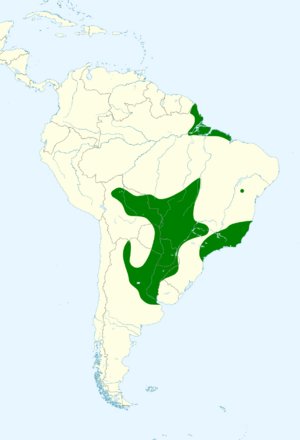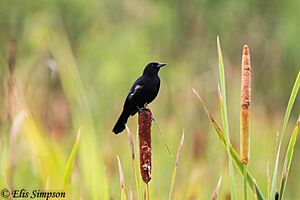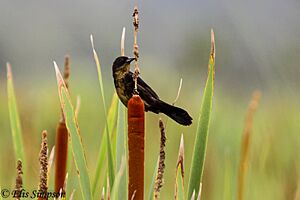Unicolored blackbird facts for kids
Quick facts for kids Unicolored blackbird |
|
|---|---|
 |
|
| Conservation status | |
| Scientific classification | |
| Genus: |
Agelasticus
|
| Species: |
cyanopus
|
 |
|
| Synonyms | |
|
Agelaius cyanopus Vieillot, 1819, Chrysomus cyanopus |
|
The unicolored blackbird (Agelasticus cyanopus) is a cool bird that belongs to the Icteridae family. This family includes many types of blackbirds and orioles. You can find this bird in parts of South America, like Argentina, Bolivia, Brazil, and Paraguay. It loves to live in swamps and the grassy areas nearby. Good news! This bird is quite common. Because of this, the International Union for Conservation of Nature says it's a "least-concern species". This means it is not in danger right now.
Contents
Meet the Unicolored Blackbird
The male unicolored blackbird truly lives up to its name. It is completely glossy black all over. Its eyes are dark, too. However, the males and females look very different. This is called sexual dimorphism.
The female unicolored blackbird has streaks of brown and black. Her belly is yellow with brown streaks. Her face has a dark mask, and her wings are reddish-brown with black edges. Females living in the lower Amazon region and southeastern Brazil look a bit duller. Their wings are less reddish, and their underparts are less yellow. Both males and females have black legs and black eyes. Their bill is long and sharply pointed.
The male unicolored blackbird might look similar to the velvet-fronted grackle or the chopi blackbird. This bird has a loud call that sounds like "tchew-tchew-tchew". It often sings this call from a high spot. It also makes different trilling and rattling sounds. These sounds can change in tone and pitch.
Where Unicolored Blackbirds Live
The unicolored blackbird lives in South America. Its home stretches from northern Bolivia and southern Brazil. It also reaches northern Argentina. This includes a large part of the lower Amazon region.
You can find these birds in marshes. They also live near the edges of ponds and lakes. They like the grassy areas next to these water bodies. They can live at heights up to about 600 metres (2,000 ft) above sea level. They are especially common in the Brazilian Pantanal, which is a huge wetland area.
How Unicolored Blackbirds Behave
This bird usually travels in pairs. It is not as social as the chestnut-capped blackbird. The chestnut-capped blackbird lives in similar swampy places. The unicolored blackbird moves around on plants that float on the water. It looks for food among the tall reeds. It always stays close to the water.
Conservation Status
The total number of unicolored blackbirds is more than 10,000 adult birds. This population is believed to be stable. The bird also lives across a very wide area. It is a fairly common species. However, its distribution can be a bit patchy, meaning it's not found everywhere in its range. The unicolored blackbird does not seem to be facing any special dangers. Because of this, the International Union for Conservation of Nature has decided its conservation status is "least concern".




